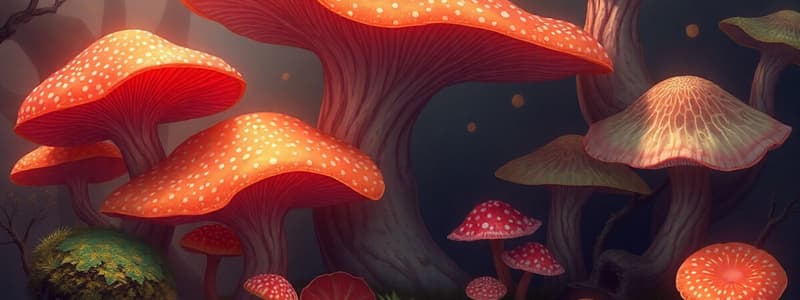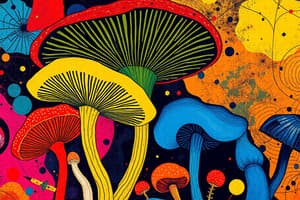Podcast
Questions and Answers
Which of the following fungal phyla includes fast-growing molds and parasitic species?
Which of the following fungal phyla includes fast-growing molds and parasitic species?
- Basidiomycota
- Ascomycota
- Glomeromycota
- Zygomycota (correct)
What is the asexual reproductive structure of Zygomycetes called?
What is the asexual reproductive structure of Zygomycetes called?
- Basidion
- Sporangium (correct)
- Ascus
- Mycelium
Which type of fungi primarily acts as decomposers in ecosystems?
Which type of fungi primarily acts as decomposers in ecosystems?
- Decomposers (correct)
- Chytrids
- Ascomycetes
- Glomeromycetes
Which phylum is noted for forming beneficial symbiotic relationships with plant roots?
Which phylum is noted for forming beneficial symbiotic relationships with plant roots?
What percentage of the fungal kingdom does Ascomycetes represent in terms of species diversity?
What percentage of the fungal kingdom does Ascomycetes represent in terms of species diversity?
What characteristic is NOT typical of fungi?
What characteristic is NOT typical of fungi?
Which of the following is a type of hyphae structure found in fungi?
Which of the following is a type of hyphae structure found in fungi?
What type of nutrition do fungi primarily utilize?
What type of nutrition do fungi primarily utilize?
What structure do hyphae form when they cluster together?
What structure do hyphae form when they cluster together?
During which stage of reproduction does karyogamy occur in fungi?
During which stage of reproduction does karyogamy occur in fungi?
What type of reproduction do fungi utilize to form spores?
What type of reproduction do fungi utilize to form spores?
Which of these statements about haustoria is true?
Which of these statements about haustoria is true?
What is the correct sequence of events in fungal sexual reproduction starting from spore germination?
What is the correct sequence of events in fungal sexual reproduction starting from spore germination?
What is the primary sexual reproductive structure in mushrooms?
What is the primary sexual reproductive structure in mushrooms?
What type of spores do basidia hold?
What type of spores do basidia hold?
Which of the following is NOT a body type of lichens?
Which of the following is NOT a body type of lichens?
What type of association characterizes lichens?
What type of association characterizes lichens?
Which structure in mushrooms is lined with club-like structures?
Which structure in mushrooms is lined with club-like structures?
Which of the following is a function of basidiospores?
Which of the following is a function of basidiospores?
What happens during karyogamy in mushrooms?
What happens during karyogamy in mushrooms?
In which type of environment are lichens most likely to be pioneers?
In which type of environment are lichens most likely to be pioneers?
What type of reproductive structure is a zygosporangium?
What type of reproductive structure is a zygosporangium?
In the lifecycle of Zygomycota, which process follows karyogamy?
In the lifecycle of Zygomycota, which process follows karyogamy?
What is the primary asexual reproductive structure in the Phylum Ascomycota?
What is the primary asexual reproductive structure in the Phylum Ascomycota?
Which type of nuclei are found in a young zygosporangium?
Which type of nuclei are found in a young zygosporangium?
What is the role of sporangia in Zygomycota?
What is the role of sporangia in Zygomycota?
Which of the following is a characteristic of the genus Rhizopus?
Which of the following is a characteristic of the genus Rhizopus?
Which statement best describes the gametangia in Zygomycota?
Which statement best describes the gametangia in Zygomycota?
In the life cycle of Zygomycota, which structure is involved in the asexual phase?
In the life cycle of Zygomycota, which structure is involved in the asexual phase?
What is the main sexual reproductive structure found in Phylum Ascomycota?
What is the main sexual reproductive structure found in Phylum Ascomycota?
Which of the following terms refers to the asexual spores produced by Penicillium sp.?
Which of the following terms refers to the asexual spores produced by Penicillium sp.?
What type of reproduction results in the formation of ascospores within asci?
What type of reproduction results in the formation of ascospores within asci?
Which of the following organisms is an example of an ascocarp?
Which of the following organisms is an example of an ascocarp?
In the life cycle of Ascomycota, what event occurs immediately after the formation of a dikaryotic mycelium?
In the life cycle of Ascomycota, what event occurs immediately after the formation of a dikaryotic mycelium?
What type of spores are produced through meiosis in the fruiting body of Ascomycota?
What type of spores are produced through meiosis in the fruiting body of Ascomycota?
Which phrase best describes the relationship between ascospores and asci?
Which phrase best describes the relationship between ascospores and asci?
Which type of reproduction involves the dispersal of haploid spores?
Which type of reproduction involves the dispersal of haploid spores?
Flashcards
Decomposers
Decomposers
Organisms that break down dead organic matter, releasing nutrients back into the ecosystem.
Parasites
Parasites
Organisms that live on or in another organism (host) and benefit at the host's expense.
Mutualists
Mutualists
Organisms that interact in a way that benefits both.
Zygomycota
Zygomycota
Signup and view all the flashcards
Ascomycota
Ascomycota
Signup and view all the flashcards
Fungal Characteristics
Fungal Characteristics
Signup and view all the flashcards
Heterotrophic Nutrition
Heterotrophic Nutrition
Signup and view all the flashcards
Saprophytic
Saprophytic
Signup and view all the flashcards
Exoenzymes
Exoenzymes
Signup and view all the flashcards
Hyphae & Mycelium
Hyphae & Mycelium
Signup and view all the flashcards
Septate/Aseptate Hyphae
Septate/Aseptate Hyphae
Signup and view all the flashcards
Haustoria
Haustoria
Signup and view all the flashcards
Fungal Reproduction
Fungal Reproduction
Signup and view all the flashcards
Zygosporangium
Zygosporangium
Signup and view all the flashcards
Zygospore
Zygospore
Signup and view all the flashcards
Sporangia (Asexual)
Sporangia (Asexual)
Signup and view all the flashcards
Plasmogamy
Plasmogamy
Signup and view all the flashcards
Karyogamy
Karyogamy
Signup and view all the flashcards
Conidiophore
Conidiophore
Signup and view all the flashcards
Conidia
Conidia
Signup and view all the flashcards
Ascocarp
Ascocarp
Signup and view all the flashcards
Ascus
Ascus
Signup and view all the flashcards
Sexual Reproduction in Ascomycota
Sexual Reproduction in Ascomycota
Signup and view all the flashcards
Asexual Reproduction in Ascomycota
Asexual Reproduction in Ascomycota
Signup and view all the flashcards
Phylum Basidiomycota
Phylum Basidiomycota
Signup and view all the flashcards
Basidiocarp
Basidiocarp
Signup and view all the flashcards
Basidiospores
Basidiospores
Signup and view all the flashcards
Dikaryotic mycelium
Dikaryotic mycelium
Signup and view all the flashcards
Lichen
Lichen
Signup and view all the flashcards
Foliose, Fruticose, Crustose
Foliose, Fruticose, Crustose
Signup and view all the flashcards
Study Notes
Kingdom Fungi
- Fungi are a diverse group characterized by multicellular structure and cell walls.
- Fungi are heterotrophic, meaning they obtain nutrients by absorbing them from their surroundings. This can take the form of saprophytic (decomposers) nutrition, parasitic nutrition, or symbiotic relationships.
- Fungi have hyphae (filaments), which can be septate (with cross-walls) or aseptate (without cross-walls).
- Hyphae form a network called mycelium.
- Some fungi possess haustoria, specialized hyphae used to penetrate host tissue.
- Fungi reproduce sexually and asexually, both resulting in spore formation. The formation of spores from both sexual and asexual cycles are crucial for fungal reproduction.
- Fungi have diverse metabolic activities, playing roles as decomposers, parasites, and mutualists.
Fungal Divisions
- Zygomycota, Ascomycota, and Basidiomycota are three major divisions of fungi.
- Zygomycetes are fast-growing molds, parasites, and commensal symbionts. Reproduction includes a sporangium (holder of asexual spores) and a zygosporangium (contains a zygospore - sexual spore).
- Ascomycetes are a diverse group that includes marine, freshwater, and terrestrial species. Asexual reproduction occurs via specialized structures called conidiophores that produce conidia (asexual spores). The sexual reproductive structures are called ascocarps, which contain ascospores (within asci).
- Basidiomycota are characterized by mushrooms, puffballs, and shelf fungi. They reproduce only sexually in a structure called a basidiocarp. Basidia are club-like structures that hold basidiospores.
Lichens
- Lichens are a symbiotic partnership between fungi (usually ascomycetes) and algae or cyanobacteria.
- Lichens have three main growth forms: foliose (leaf-like), fruticose (shrub-like), and crustose (encrusting).
- Lichens are important pioneer organisms, aiding in soil formation on bare rock.
Studying That Suits You
Use AI to generate personalized quizzes and flashcards to suit your learning preferences.




